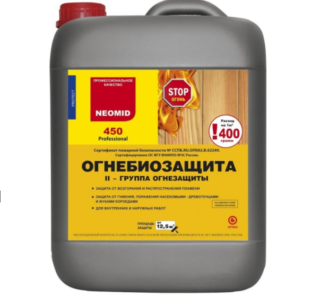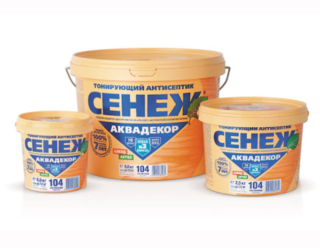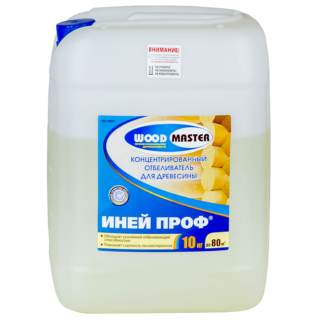Wooden houses are environmentally friendly housing with a favorable microclimate. The use of timber in construction provides durability, aesthetic appeal and excellent thermal insulation. With many advantages, the material is characterized by poor resistance to moisture, fire, and the effects of biological factors. Treating the house with special protective compounds will prevent the destruction of the tree structure.
The need to process timber inside the house
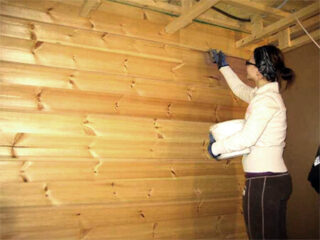
Wood is exposed to the environment, even from the inside of the wall can suffer from negative factors:
- Moisture - hygroscopic material quickly absorbs water that gets on the walls, and is saturated with it from the air. An increase in humidity leads to swelling of the timber and is a favorable environment for the development of fungi and mold.
- Fire - wood is highly flammable and sustains combustion, in the event of a fire, you can lose the entire structure.
- Microorganisms - Natural wood is a natural habitat for fungi, bacteria and insects. The affected material turns into an unpleasant color and gradually collapses. The biological effect reduces the strength of the structure, shortens the life of the dwelling.
Special attention is paid to the processing of rooms with high humidity: kitchen, bathroom, sauna.
When to process
The use of protective preparations begins before the assembly of the structure. Profiled and glued timber needs to be protected from moisture. It is thoroughly covered with an antiseptic from all sides. After the walls and floors have been erected, this will no longer be possible, some of the lumber will become inaccessible. Also, the wood is impregnated with fire retardants that prevent combustion.
When choosing how to process a wooden house from a bar outside immediately after construction, pay attention to the products of the Senezh company. These are hard-to-wash antiseptics, wood protection products with wax and UV filters, primers that will prevent rot and insects. They penetrate well into wood and form 2 levels of biosecurity. Experts recommend the use of protective drugs of Russian brands Neomid, Belinka, Aquatex.
The compositions are applied during the first months after the construction of the building, without waiting for its shrinkage. The bar is covered with drugs simultaneously from the inside and outside. This procedure should be carried out regularly every 3-4 years.
Impregnation can be not only protective, but also decorative. She is able to lighten wood, give it a different shade. Glued laminated timber has an aesthetic appearance, so it is enough to paint it with varnish. After applying the antiseptic, it is better to sheathe the profiled material with clapboard.
Requirements for processing tools
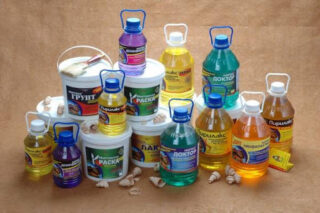
Antiseptics and fire retardants must fully protect the tree from harmful effects. But no less important requirements are imposed on the means of internal processing:
- Environmental friendliness and safety - when choosing how to process timber or logs inside the house, pay attention to the components of the drug.You need to buy products without toxin additives and odor, preferably water-based products. They contain borax, boric acids, sodium salts, which are antiseptics.
- The duration of action is the optimal period of 3-5 years.
- Profitability - the criterion is determined by the ratio of the price of the material and its consumption.
Manufacturers take into account the peculiarities of the use of the formulations, therefore, they select safe ingredients. In order not to harm your health, choose products labeled "for internal use".
Types of materials
Fire retardants
Chemicals, when applied to the wood surface, significantly reduce the flammability of the wood. According to the mechanism of action, fire retardants are divided into two groups:
- Products emitting non-combustible gases that block the access of oxygen to the surface of the tree. The base is ammonium sulfate or ammonia.
- Compositions containing low-melting salts of boric, phosphoric or silicic acid. They increase the combustion temperature, cover the wood with a fire-resistant film.
Fire protection products are available in the form of paints, varnishes or impregnations. Best of all, drugs of the first group of effectiveness resist the outbreak of fire.
Antiseptic drugs
- Impregnations - penetrate a few centimeters deep into the tree, destroy existing microorganisms and prevent their further appearance.
- Film-forming compounds - form a protective coating on the surface that does not allow moisture and biological pests to pass through.
Compositions for internal use are transparent (glazing) and coating. They give the wood the desired color. To change the tone of the timber, preserving the structure of the wood, take a toning antiseptic (stain).
Biopyrens
Preparations of complex action have antiseptic and fire-retardant properties. They are approved for use in residential premises, children's and medical institutions. The formulations destroy fungi and insects, prevent their appearance. They are designed for processing hardwood and coniferous timber.
Primer
Antiseptic agents are used as a preliminary surface coating for painting or varnishing. They penetrate deeply into the structure of the tree, reduce the consumption of paints and varnishes.
Whitening products
- Chlorine-containing preparations are effective remedies, but they are harmful to health, they are used for external processing.
- Based on active oxygen - the composition is safe, perfectly brightens and disinfects wood.
- Oxalic acid is a less potent remedy recommended for soft woods.
Whitening agents are applied according to the instructions, kept for the specified time and washed off if required by the manufacturer. To prevent further infection, a deep penetration antiseptic is applied.
Preparatory work
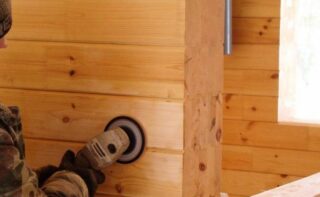
The compounds must not be applied to old paintwork, dirt, resin or damaged timber. Before processing a wooden house outside and inside, the surface is prepared. Old paint or varnish is heated until softened and removed with a scraper. Then the blockhouse is sanded with a special machine. The procedure allows you to remove irregularities and defects, dark spots, and improves the appearance of the material.Removing the top layer opens the wood pores, allowing deep penetration of the impregnation. Grinding is done with coarse and fine abrasives. After the procedure, the surface and surrounding objects are cleaned with a vacuum cleaner.
DIY application technology
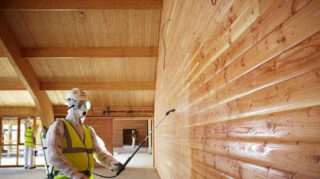
After cleaning the sanded bar, you need to inspect its surface. Places darkened by the fungus are treated with a bleaching compound. It is applied with a brush or roller, rubbed thoroughly into the surface. The rest of the solution is washed off after 10-12 hours. Work is carried out in a ventilated area.
Treatment of a house from a bar begins with the application of an antiseptic. Impregnation is carried out manually (with a brush, roller) or using a spray gun. The mechanized method speeds up the work, reduces labor costs. The advantage of brushing is the ability to process hard-to-reach areas. The antiseptic is applied in 1-2 layers, taking a break until it dries completely. The lower parts of the house, rooms with high humidity (bathrooms, bathrooms, kitchens) are covered with special care with the composition.
Further, the timber is treated with a fire retardant, the solution is applied in the same way. If complex protection with biopirens is applied, then the two stages are combined into one. Before finishing, the timber is covered with a primer. After it dries, a coloring composition or varnish is applied.
Internal processing recommendations
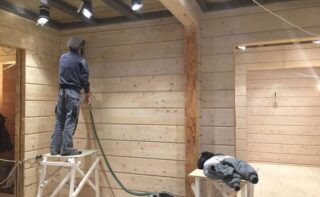
If the completion of the construction of the house took place in the winter, processing should be postponed until the onset of the thaw. Most formulations are applied only at positive temperatures. In cold weather, untimely impregnation is not dangerous, the tree does not gain moisture, and insects and fungi are inactive. For water-soluble preparations, the minimum application temperature is + 10 ° C.
Work begins from the bottom of the building, which is in constant contact with moisture. It is necessary to cover the logs of the subfloor board, the lower overlap with protective agents. The next step is the processing of walls, ceilings, interfloor ceilings and other wooden structural elements.
Protective agents are applied sequentially: antiseptic, fire retardant, primer, finishing (acrylic-based coloring composition, varnish).
Special safety requirements are imposed on formulations for internal use. Choose water-based products, free from organic solvents and synthetic oils. They must be odorless and have good vapor permeability.
It is recommended to apply the preparations in several layers, this will provide deeper penetration into the wood layers, long-term and reliable protection.

